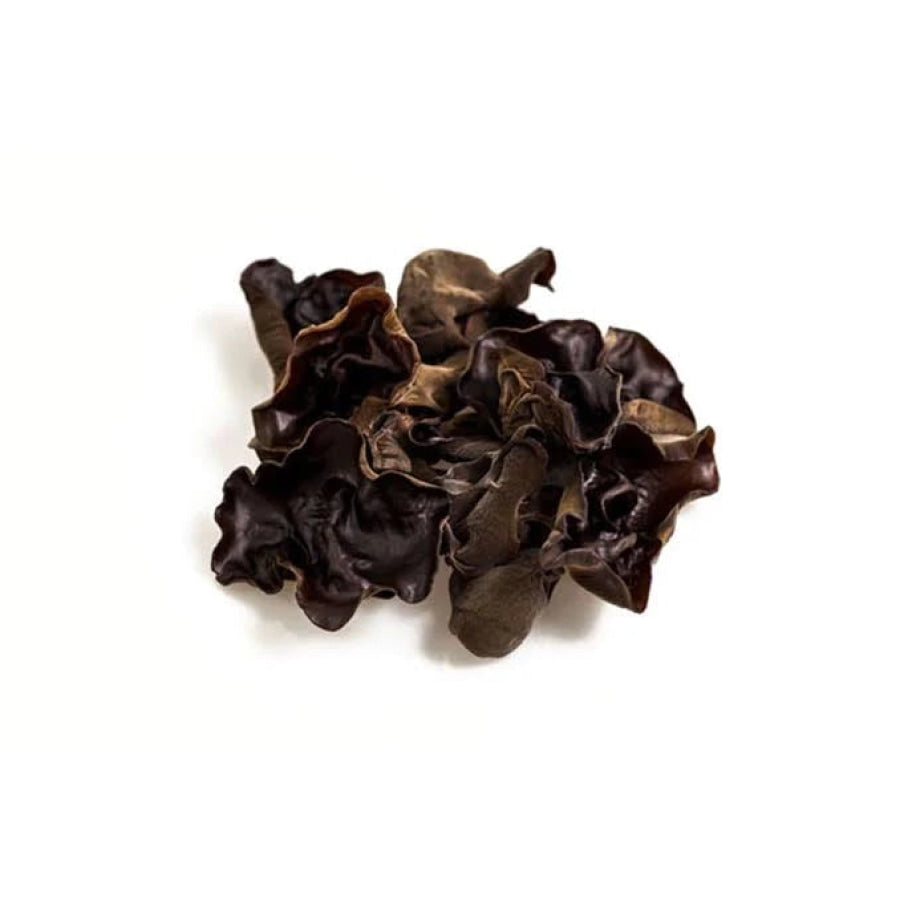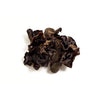Dried Black Fungus Mushroom - Fresh Aisle
- Product SKU: FRA/4738
- Order within
Black fungus (Auricularia polytricha) is an edible wild mushroom sometimes known as tree ear or cloud ear fungus, given its dark, ear-like shape.
While predominantly found in China, it also thrives in tropical climates like the Pacific Islands, Nigeria, Hawaii, and India. It grows on tree trunks and fallen logs in the wild but can be cultivated as well (1).
Known for its jelly-like consistency and distinct chewiness, black fungus is a popular culinary ingredient across a range of Asian dishes. It has likewise been used in traditional Chinese medicine for hundreds of years (2).
This article reviews the uses, nutrients, and benefits of black fungus, as well as any precautions you may need to take.
Black fungus is usually sold in dried form. Before you eat it, it needs to be reconstituted in warm water for at least 1 hour.
While soaking, the mushrooms expand 3–4 times in size. Keep this in mind when you’re cooking, as small amounts can go a long way.
While black fungus is marketed under several names, it’s technically different than the wood ear mushroom (Auricularia auricula-judae), its botanical cousin. Nonetheless, these fungi boast similar nutrient profiles and culinary uses and are sometimes referred to interchangeably (1).
Black fungus is a popular ingredient in Malaysian, Chinese, and Maori cuisine.
It’s a bit coarser than the wood ear mushroom and frequently used in soups. As it has a fairly neutral taste, it’s even added to Cantonese desserts. Like tofu, it absorbs the flavors of the dish it’s a part of.
Since the 19th century, black fungus has been used in traditional Chinese medicine to alleviate symptoms of several conditions, including jaundice and sore throats (2).
SUMMARY
Black fungus is fairly neutral in taste and can take on many flavors. It’s quite popular in Asia, where it’s regularly added to soups, and it has long been used in traditional Chinese medicine.
Black fungus (Auricularia polytricha) is an edible wild mushroom sometimes known as tree ear or cloud ear fungus, given its dark, ear-like shape.
While predominantly found in China, it also thrives in tropical climates like the Pacific Islands, Nigeria, Hawaii, and India. It grows on tree trunks and fallen logs in the wild but can be cultivated as well (1).
Known for its jelly-like consistency and distinct chewiness, black fungus is a popular culinary ingredient across a range of Asian dishes. It has likewise been used in traditional Chinese medicine for hundreds of years (2).
This article reviews the uses, nutrients, and benefits of black fungus, as well as any precautions you may need to take.
How is black fungus used?Black fungus is usually sold in dried form. Before you eat it, it needs to be reconstituted in warm water for at least 1 hour.
While soaking, the mushrooms expand 3–4 times in size. Keep this in mind when you’re cooking, as small amounts can go a long way.
While black fungus is marketed under several names, it’s technically different than the wood ear mushroom (Auricularia auricula-judae), its botanical cousin. Nonetheless, these fungi boast similar nutrient profiles and culinary uses and are sometimes referred to interchangeably (1).
Black fungus is a popular ingredient in Malaysian, Chinese, and Maori cuisine.
It’s a bit coarser than the wood ear mushroom and frequently used in soups. As it has a fairly neutral taste, it’s even added to Cantonese desserts. Like tofu, it absorbs the flavors of the dish it’s a part of.
Since the 19th century, black fungus has been used in traditional Chinese medicine to alleviate symptoms of several conditions, including jaundice and sore throats (2).
SUMMARY
Black fungus is fairly neutral in taste and can take on many flavors. It’s quite popular in Asia, where it’s regularly added to soups, and it has long been used in traditional Chinese medicine.



















